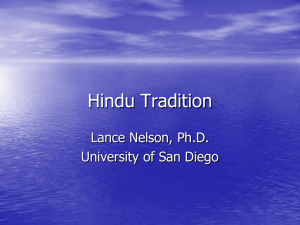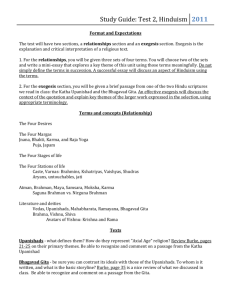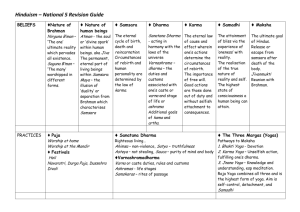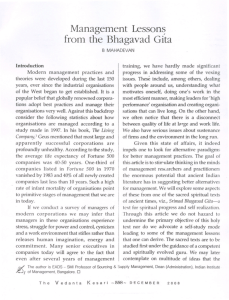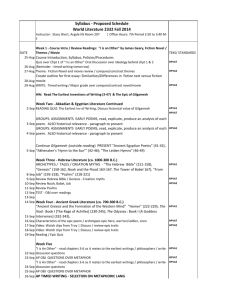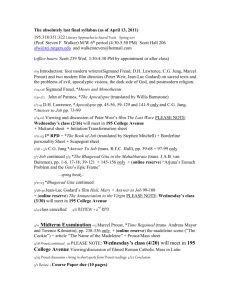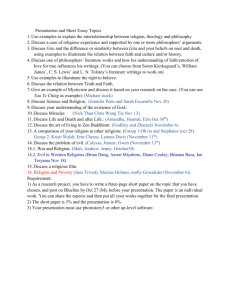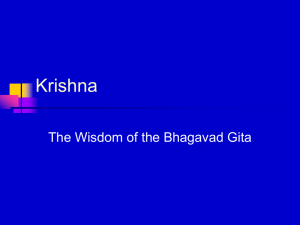Bhagavad Gita
advertisement
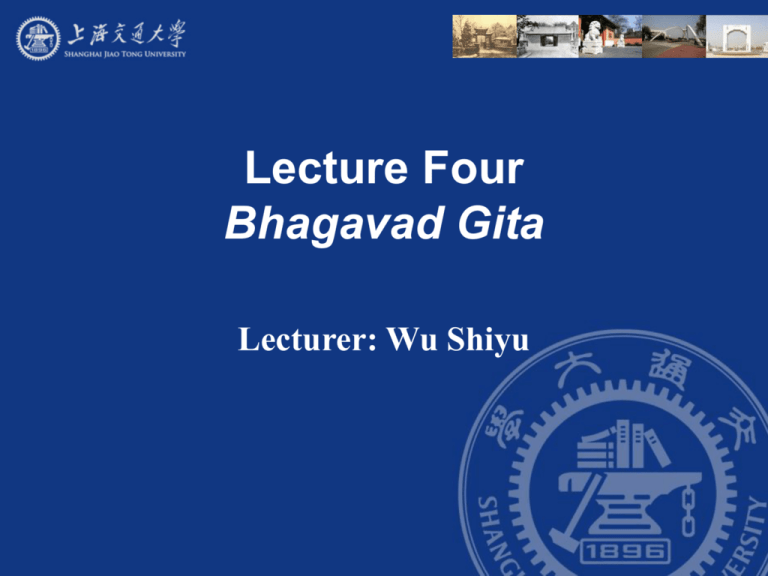
Lecture Four Bhagavad Gita Lecturer: Wu Shiyu Outline I. This session begins with a review of the first three lectures. A. Great books are books that speak to us individually and represent books and authors that have made history. These books have lived past their time and can influence our lives and events today. Great books have a great theme, are written in noble language, and are able to speak across the ages. B. The course is developed around eternal themes: God, fate, good and evil, the meaning of life, and how people live their lives in pursuit of truth. The books discuss duty and responsibility; law, justice, and government; love and beauty; courage, honor, and ambition; our relationship to nature; and our definition of education. 1. Bonhoeffer’s Letters and Papers From Prison is the work of a man in search of truth who found the courage to resist evil and who gave his life in the pursuit of good. His ideas have lived on despite Hitler’s attempt to crush them. The civil rights movement of the 1960s found special relevance in this work. 2. Homer’s Iliad offers wisdom to us today in such central themes as God, fate, and the meaning of good and evil. It also teaches how to live life with courage while understanding the virtue of moderation. It is the first great work of classical Greek literature that has come down to us. 3. The Meditations of Marcus Aurelius represents the summation of Greek thought on God, fate, and good and evil. The Roman Empire of Marcus Aurelius, which was the Roman Empire of the 1st and 2nd centuries A.D., was the cultural heir of Greece, and Marcus Aurelius wrote the Meditations in Greek. The writings of Marcus Aurelius represent the culmination of the transformation of the god Zeus from the capricious and lecherous master found in the poetry of Homer to a god who is associated with absolute truth and good and who is equated with nature, is all-powerful, all-knowing, and all-seeing. C. In the same way that the Romans were the cultural heirs of the Greeks, the United States of today is the cultural heir of Europe. II. The culmination of an image of god as a vision of truth can be found perhaps as early as 500 B.C. in the Bhagavad Gita, the “Song of God.” This work was a product of classical Indian civilization. A. Around 1800 B.C., the flourishing civilizations around the Indus River were overrun by invaders from the west. B. The language of these invaders was Sanskrit, also the language of the Bhagavad Gita. Sanskrit was related to Persian and more distantly to Greek, Latin, and the Germanic languages. C. These invaders, who called themselves Aryans, meaning “nobles,” imposed their rule by conquest. From warfare and destruction came a new civilization that produced rich poetry, including the Bhagavad Gita, in an epic form. D. The religion of this people was Hinduism, a polytheistic religion that rejects the notion that the world of the gods is finite, but is willing to recognize any new divine power capable of rendering supernatural benefits to the community of worshipers. All nature was seen as a manifestation of the divine. Sacrifice is fundamental to this worship; it can be used to offer homage to the gods in return for their blessings and to avert evil. Individual gods can take many forms. As in Homer’s Iliad and the writings of Marcus Aurelius, this polytheistic notion of the divine can foster an image of one all-powerful and universal god. III. The Bhagavad Gita is part of a longer work, the Mahabharata A. It is a poem that presents an epic story of warfare. B. Its author is unknown C. The warfare in the Bhagavad Gita is a symbol of the ongoing conflict of life and the struggle for the wisdom to live life in a way that is meaningful to us as individuals. It is the struggle between two warring tribes; it is also a struggle between right and wrong and between good and evil. D. At the beginning of the story, Arjuna, the hero, does not understand the nature of his struggle and wishes to withdraw from the war. IV. Truth is a central idea of the Bhagavad Gita. A. The first word of the Bhagavad Gita is dharma, or “truth.” B. In this allegory, Krishna, the charioteer of Arjuna, is also the image of the supreme god of the universe; Arjuna is everyman, the soul. Krishna explains to Arjuna how he must travel the battlefield of life. C. Gandhi’s statements reflect the theme of the Bhagavad Gita. Gandhi said that it is more important to believe that truth is God than that God is truth. Truth comes first. D. Krishna’s message to Arjuna is that Arjuna must be steadfast in the truth and must fight the battle of life understanding what truth is. V. The Bhagavad Gita also explains that behind the changing formations of the divine, there is one underlying divine being who is all and that Krishna is one of his manifestations. A. God’s presence is everywhere throughout all things in the universe. B. In the Bhagavad Gita, God makes himself visible in his true form to Arjuna. This God is everywhere throughout the universe. The universe is contained in one atom of this divine being, and in every person, there is a part of this divine being. VI. After this glimpse of the majesty of God and the understanding that God is all, an individual can come to an understanding of his or her role in the universe that God has created. That role is our soul. A. This idea contrasts with the viewpoints seen in both the Iliad and the Mediations. Marcus Aurelius was unsure of the existence of the soul; if it did exist, he believed that it came to an end at death. For Homer, this life is what we have and we must live it. B. In the Bhagavad Gita, the soul endures, is eternal, and is divine. The task of mankind is to purify the soul and gain wisdom and truth so that the soul can gain ultimate liberation. C. This ultimate liberation is the next step. The body is seen as a prison; bodily desires are the result of false knowledge and false wisdom (for example, the desire for power and wealth). Wisdom enables a person to begin to shed false desires. 1. The path of wisdom is to lead us to a stage that frees the soul for eternity from the bondage of the body. 2. Power leads to no ultimate liberation; after death, an individual becomes some other creature. 3. The fate an individual earns through making choices affects that individual for many cycles of death and rebirth. 4. The Bhagavad Gita is about making the correct choices through wisdom. Earthly actions are good or evil and have enduring consequences. Choices using true wisdom allow a person to ultimately gain eternal liberation. D. Wisdom consists of understanding karma, which means the task that an individual has been assigned by God. Karma is the role and the task of the individual. The choice to accept karma must be made with full realization of the difficulty of performing one’s duty. Krishna teaches Arjuna that his duty is to fight this war. 1. A person who renounces his or her assigned task is 2. 3. 4. 5. doomed to eternal reincarnation and suffering. Accepting the assigned task with fear also leads to endless cycles of reincarnation. Accepting the task with a whole heart allows a being to rise a step or two. Accepting the task with supreme spirit and a fully dutiful conscience and understanding can lead to ultimate liberation and the pure bliss of unification with God, which is ultimate freedom. The decision to follow the assigned way can bring a being to liberation. Even the greatest sinner can be liberated by doing his or her task to the utmost. VII. The religion of the Bhagavad Gita is not a renunciation of life. It is the call to learn the ultimate meaning of life. The Bhagavad Gita answers the questions of God, good and evil, and fate. It also deals with truth, duty, justice, and love. A. God is all, God is eternal and everlasting, and God pervades the entire universe. B. Good is following the mission of one’s life. C. On the subject of fate, the Bhagavad Gita indicates that every individual and particle of the universe has a destiny. An individual must have the wisdom to know his or her destiny. D. Truth is everything and all things. E. Duty and responsibility are assigned by God and may lead away from what other people recommend. F. Ultimate justice lies in every particle of the universe willingly and joyfully carrying out the will of God. The Bhagavad Gita does not separate the world, God, fate, life, and government. They are all mingled in the total vision of the world and justice. Justice is not of men but is part of the divine order. The person of justice is unshakable and steadfast in the truth. G. Love led Krishna to take form in this world so that Arjuna could see him. An individual’s love is to become absolutely immersed in the divine; to do that, one may forsake all things and put oneself on God’s path. VIII. The ultimate message of the Bhagavad Gita is that God has created many roads to the truth; each person must find his or her own road. A. These roads may include ritual sacrifices, a life of religious piety, contemplation and study, or struggle for liberation. Gandhi understood that his path was to struggle for the liberation of his country. B. The Hindu never seeks to absolutely define the world of the gods. There are many different forms of God, and each one may have a role in leading one individual to an understanding of truth. C. The form or ceremonies of God are not important. What is important is the understanding that God is truth. That understanding gives one the courage to live life and follow karma. IX. The Bhagavad Gita, like the Divine Comedy, is one of the greatest works of education ever composed. It leads from the darkness of a life without meaning to the clarity of God’s wisdom. X. The civilizations of classical Greece and classical India may have had some contact with each other. However, classical Indian civilization has little regard for history or for concrete knowledge of the past. Although similarities exist between the vision of divine glory in Dante’s Divine Comedy and the Bhagavad Gita, the classical Indian view would be that these similarities represent eternal and enduring wisdom that is deeper than history. 谢 谢!
